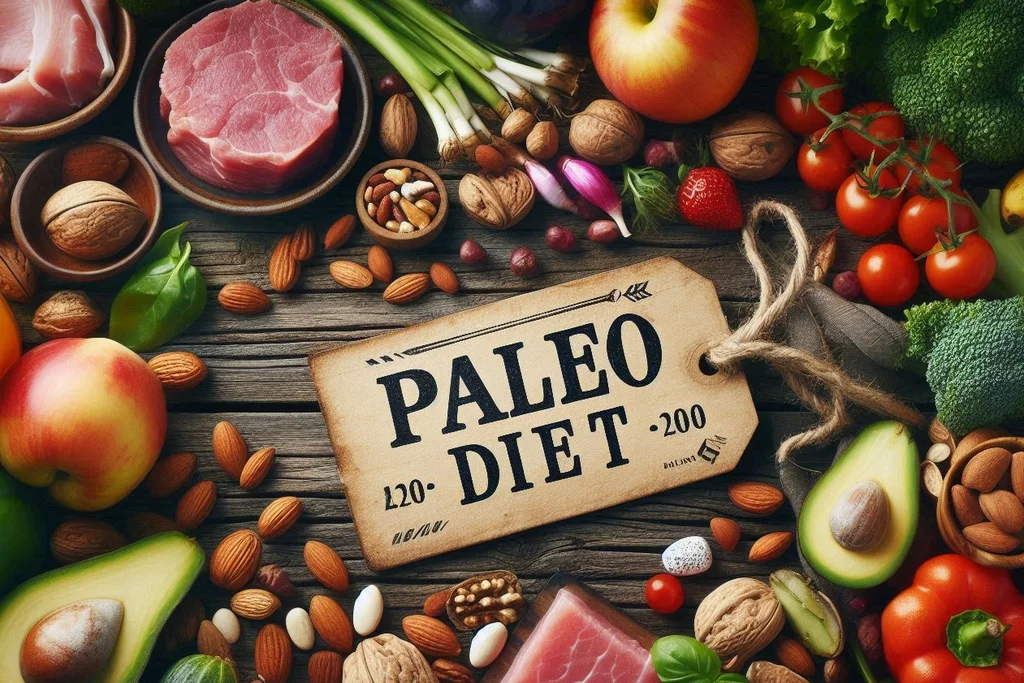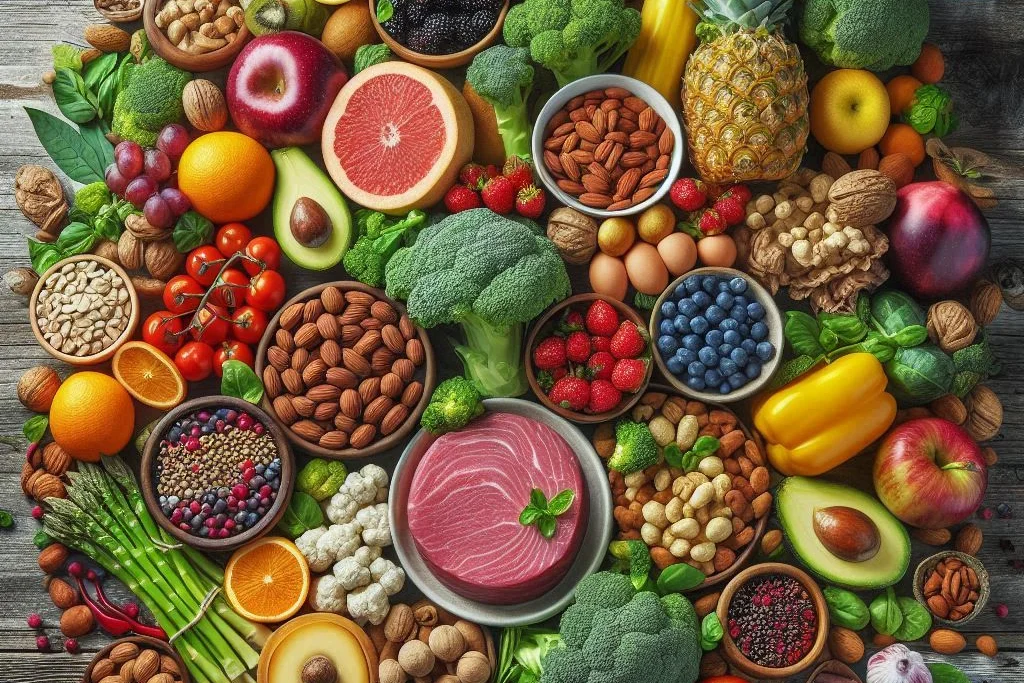Diet Guide – Paleo Diet
Curious about how the paleo diet can transform health and energy? Discover simple meal plans and expert tips to get started now!

This article is part of a series. Check them out all!
Introduction to the Paleo Diet: A Whole-Foods Approach Inspired by Ancestral Eating
The paleo diet has been developed to reflect the presumed dietary patterns of ancient hunter-gatherer populations.
Exact details of ancestral eating habits remain uncertain across different regions; however, research indicates that diets were composed primarily of whole, unprocessed foods.
By emphasizing whole foods and maintaining physically active lifestyles, significantly lower occurrences of lifestyle-related conditions—such as obesity, type 2 diabetes, and cardiovascular disease—have been observed among hunter-gatherer communities.
Substantial weight reduction, often without the need for calorie tracking, along with marked improvements in overall well-being, have been associated with this dietary approach.
It has also been proposed by anthropologists that evolutionary dietary patterns may have contributed to notable changes in human anatomy and physiology, such as enhanced brain development and a decrease in gastrointestinal tract size.

Overview of a Paleo Diet Meal Plan
Dietary patterns among Paleolithic populations varied widely, shaped by geographic location and seasonal availability of food sources.
Some groups followed low-carbohydrate diets rich in animal-based foods, while others consumed high-carbohydrate diets with an emphasis on plant-based ingredients.
Insects were also included in certain traditional diets; however, this element is generally excluded from current interpretations of the paleo approach.
Modern paleo meal plans typically emphasize
- unprocessed meats
- fish
- eggs
- vegetables
- fruits
- nuts
- seeds
- herbs
- spices
- nutritious fats and oils
Commonly excluded items
- processed foods
- added sugar
- soft drinks
- artificial sweeteners
Foods often consumed in limited quantities
- grains
- most dairy products
- legumes
Foods Commonly Excluded in the Paleo Diet
“A simple guideline for the paleo diet is, if it looks like it was made in a factory, avoid it.”

Certain food groups are generally avoided in the paleo dietary pattern due to their modern processing methods or limited presence in ancestral diets.
- Sugar and high-fructose corn syrup
found in soft drinks, fruit juices, table sugar, candy, pastries, ice cream, and similar products - Grains
including bread, pasta, wheat, cereal, spelt, rye, and barley - Legumes
such as beans, lentils, and related varieties - Most dairy products
especially low-fat options (though full-fat dairy like butter and cheese may be included in some paleo variations) - Certain vegetable oils
such as soybean, sunflower, cottonseed, corn, grapeseed, and safflower oils - Artificial sweeteners
including aspartame, sucralose, cyclamates, saccharin, and acesulfame potassium (natural sweeteners are often recommended instead) - Highly processed items
including products labeled “diet” or “low fat,” and those with numerous additives or artificial ingredients
“To avoid these ingredients, you must read ingredient lists and nutrition labels, even on foods labeled as ‘health foods.'”
Commonly Included Foods in the Paleo Diet
The paleo diet places emphasis on whole, minimally processed foods that are believed to resemble those consumed during ancestral times.

- Meat
such as beef, lamb, chicken, turkey, pork, and similar options - Fish and seafood
including salmon, trout, haddock, shrimp, and shellfish (wild-caught varieties are often preferred) - Eggs
may be sourced from free-range, pastured, or omega-3 enriched systems - Vegetables
including broccoli, kale, peppers, onions, carrots, tomatoes, and others - Fruits
such as apples, bananas, oranges, pears, avocados, strawberries, blueberries, and more - Tubers
including potatoes, sweet potatoes, yams, and turnips - Nuts and seeds
such as almonds, macadamia nuts, walnuts, hazelnuts, sunflower seeds, and pumpkin seeds - Healthy fats and oils
including extra virgin olive oil, avocado oil, and similar choices - Salt and spices
such as sea salt, garlic, turmeric, rosemary, and other herbs
“Many people prefer grass-fed meats, pastured eggs, and organic produce while following a paleo diet. However, this is not required.”
Potential Risks and Considerations of the Paleo Diet
Although the paleo diet offers various health-supporting benefits, certain limitations have been noted.
Several food groups that contain important nutrients are excluded in this approach, such as legumes, dairy products, and gluten-containing grains.
Legumes supply fiber, plant-based protein, and essential micronutrients like iron, zinc, and copper.
The removal of these groups may increase the risk of nutrient deficiencies for some individuals.
For those following vegetarian or vegan dietary patterns, the exclusion of legumes—an important protein source—can make adherence to a paleo framework more difficult.
A notable increase in fiber intake is typical when transitioning to a paleo plan due to a higher consumption of vegetables, fruits, and nuts. When this change follows a previously low-fiber diet, digestive discomfort such as bloating may occur during the adjustment period.
Getting Started with the Paleo Diet

Starting a paleo diet can be accomplished using foods commonly available in most grocery stores. No special tools, mail-order products, or calorie-counting equipment are required. Meal portions do not need to be weighed, as this approach encourages eating until satiety is reached.
A shopping list can be prepared in advance to support food selection in alignment with paleo principles.
Adoption of the diet may begin with a full transition or through a gradual approach. A flexible introduction may involve combining fully paleo meals with others that allow for greater variety. An outlined system provides four progressive levels, making it easier to adjust over time.
Entry-Level Paleo
- 50% (11 meals): TRUEPALEO — meals prepared strictly from paleo-approved foods
- 35% (7 meals): PaleoFLEX — meals that include limited amounts of sugar, salt, or other additives
- 15% (3 meals): Non-Paleo — unrestricted meal choices
Mid-Level Paleo
- 65% (14 meals): TRUEPALEO
- 20% (4 meals): PaleoFLEX
- 15% (3 meals): Non-Paleo
Top-Level Paleo
- 80% (17 meals): TRUEPALEO
- 15% (3 meals): PaleoFLEX
- 5% (1 meal): Non-Paleo
TRUEPALEO
All meals consist entirely of paleo-compliant foods, followed 100% of the time.
Simple Snack Options on the Paleo Diet
A variety of convenient snack choices align well with the paleo dietary pattern. These can be enjoyed between meals and are easy to carry:
- Toasted almonds or mixed nuts
- Hard-boiled eggs
- Fresh fruits and vegetables, such as baby carrots, celery sticks, and sliced apples
- Dairy-free chia pudding
Sample 1 Week Paleo Meal Plan
| Day | Meals (4 per day) | Estimated Macros & Calories (Daily Total) |
|---|---|---|
| Monday | 1. Scrambled eggs (2), spinach, avocado 2. Grilled chicken (~80g), roasted carrots 3. Tuna salad (60g tuna in olive oil), mixed greens 4. Apple slices, almond butter | Calories: ~1,550 kcal Protein: ~60g Fat: ~90g Carbs: ~80g |
| Tuesday | 1. Chia pudding (coconut milk, berries) 2. Turkey lettuce wraps (~75g turkey, avocado, tomato) 3. Boiled egg, roasted sweet potato 4. Veggie sticks, guacamole | Calories: ~1,520 kcal Protein: ~60g Fat: ~85g Carbs: ~90g |
| Wednesday | 1. Boiled eggs (2), zucchini, olive oil 2. Baked salmon (~60g), steamed broccoli 3. Chicken stir-fry (~80g chicken, peppers, coconut aminos) 4. Banana, walnuts | Calories: ~1,570 kcal Protein: ~60g Fat: ~95g Carbs: ~85g |
| Thursday | 1. Omelet (2 eggs, tomato, herbs) 2. Ground beef patty (~75g), roasted cauliflower 3. Grilled shrimp (~80g), arugula salad 4. Mixed berries, coconut flakes | Calories: ~1,540 kcal Protein: ~60g Fat: ~88g Carbs: ~92g |
| Friday | 1. Smoothie (banana, spinach, almond milk, chia) 2. Turkey breast (~80g), cucumber, olive tapenade 3. Boiled egg, roasted root vegetables 4. Pear, pumpkin seeds | Calories: ~1,500 kcal Protein: ~60g Fat: ~85g Carbs: ~95g |
| Saturday | 1. Fried eggs (2), mushrooms, onions 2. Baked chicken thigh (~80g), green beans 3. Sardines (~60g), mixed greens, olive oil 4. Carrot sticks, cashew butter | Calories: ~1,580 kcal Protein: ~60g Fat: ~92g Carbs: ~87g |
| Sunday | 1. Chia & flax bowl with strawberries 2. Grilled pork strips (~75g), sautéed kale 3. Sweet potato, avocado mash 4. Almonds, dried figs | Calories: ~1,560 kcal Protein: ~60g Fat: ~90g Carbs: ~90g |
